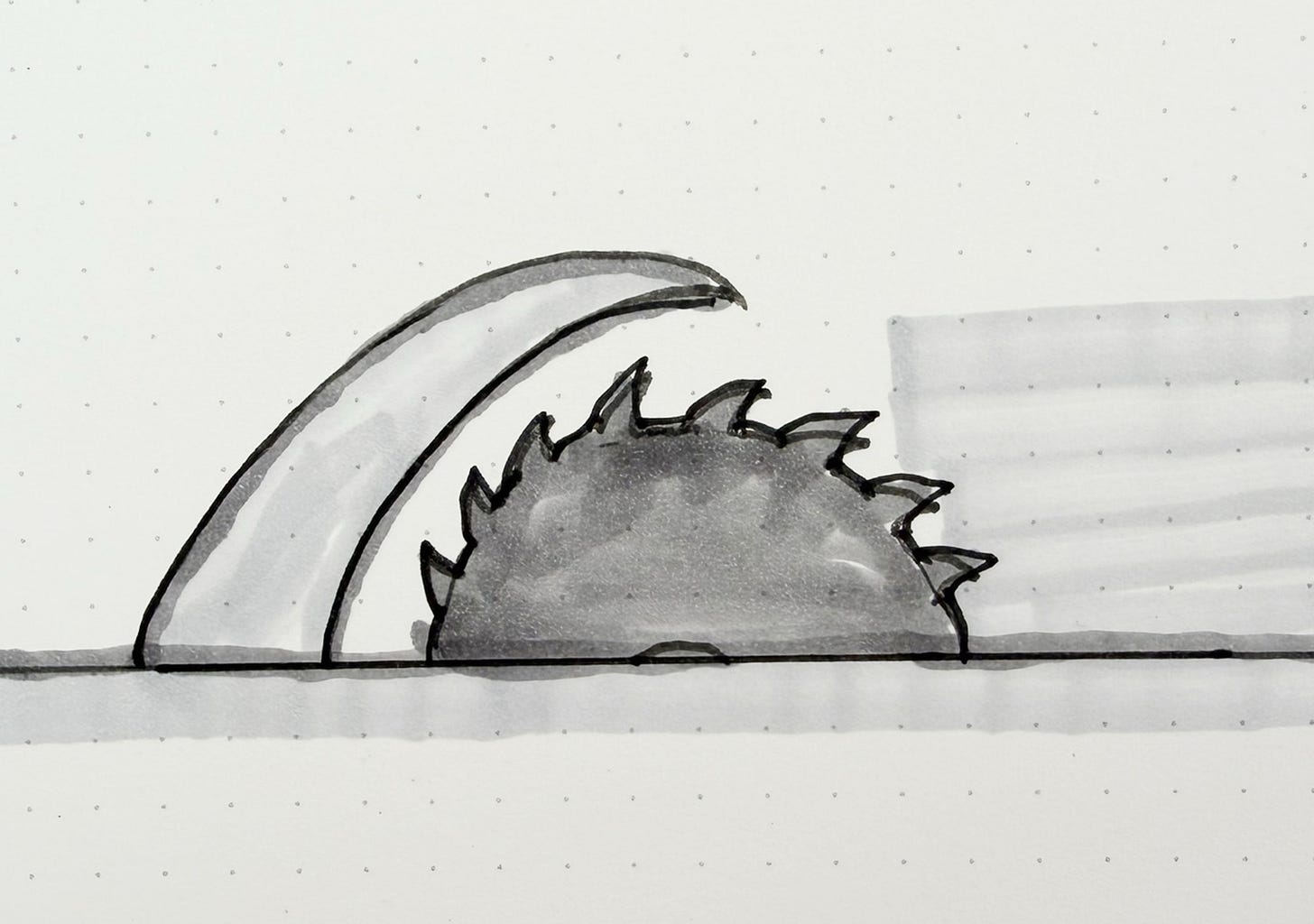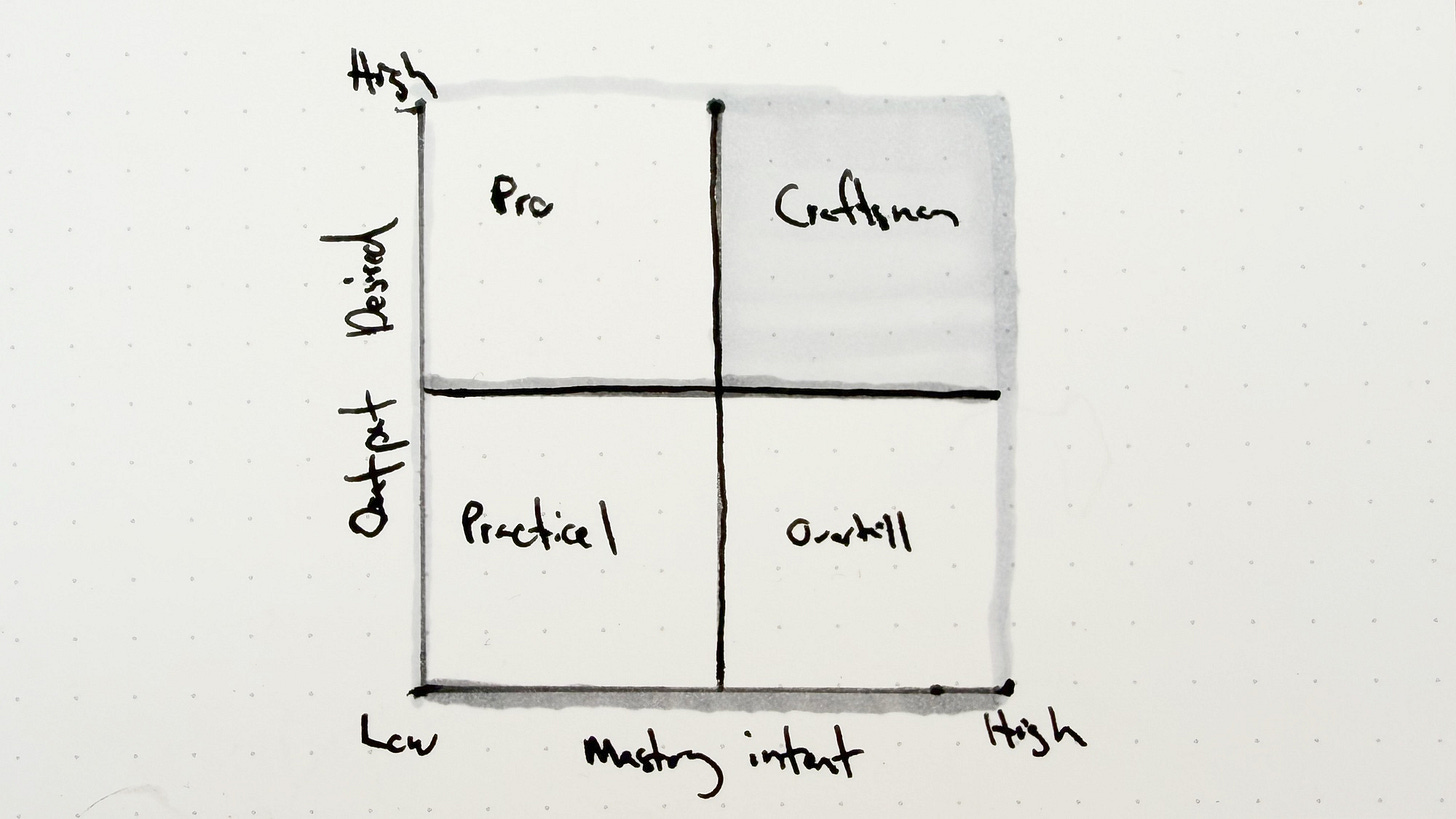Power tools
Issue 269: The importance of pro tools (for everyone)
In art school, we had a curriculum that forced us to have a well-rounded perspective of different crafts outside of our major—fostering the archetype of being a generalist. Even though I majored in Drawing and Painting, I studied several courses in Photography, Ceramics, Sculpture, Jewelry/Metalsmithing, and Wood Design.
Of all of them, Wood Design was one of the most intimidating ones because of the power tools. We spent the first few classes not building anything, but learning how the machines worked—how to respect them. The table saw, in particular, demanded attention. Every cut required setup, calibration, and awareness. One wrong move and you could ruin a project—or worse, hurt yourself. I vividly recall in high school hearing a story of a classmate cutting off a part of his thumb while working on the table saw. That memory stuck with me as I learned about woodworking to make furniture and expressive sculptures.
That experience taught me something fundamental: the quality of what you make depends on how well you understand your tools. And that lesson applies as much to design and software as it does to wood.
The table saw is a pro tool
The table saw is the centerpiece of any woodshop. It can rip long boards with perfect parallel edges, make precise miters, or cut dado joints for furniture. But to do so safely and accurately requires mastery. You must understand blade kerf, fence alignment, and feed rate. You don’t just turn it on—you plan the entire sequence of cuts before touching the wood.
In software, the Integrated Development Environment (IDE) is the equivalent of the table saw. It’s a professional setup—powerful, technical, and designed for precision. When you work in an IDE, you’re managing dependencies, debugging code, and setting up environments. There’s planning, version control, and a deep understanding of how the system works. It’s not fast at first, but the output is high-quality, scalable, and dependable.
For designers, Figma occupies a similar space. It’s precise, collaborative, and made for production-grade work. Understanding its systems of components, constraints, autolayout, and tokens requires time, but it allows teams to operate at scale. Just as the table saw demands you know the grain of the wood, Figma requires you to understand how your design system behaves.
Mastery of these tools builds confidence. It also builds safety. When you understand the machine, you’re less likely to make mistakes that cause structural or ethical harm. The end product—whether a chair, app, or brand system—holds together because you respected the process.
Consequences of not learning power tools
When someone walks into a woodshop and turns on a power tool without training, the damage isn’t always immediate, but guaranteed. In woodworking, the most common mistake isn’t cutting yourself; it’s cutting wrong. A poorly measured or rushed cut wastes the material, forces a redesign, or compromises the structure. In a craft where precision is everything, waste is the most expensive teacher.
This is what’s happening with vibe coding at the moment. People one-shot prompt their way to software without knowing how it works. What often happens is that people get very excited about their first build, which is great. However, as the project becomes more complex, they run into architectural consequences they didn’t even know: database management, version control, component libraries, package management, etc.
This behavior is the equivalent of someone on a table saw cutting wood without a clear plan or intention of what they want to make, hoping for their perfect outcome.
A person might quickly spin up an app with no-code or AI tools that seem to work fine on the surface, but the moment they need to integrate a real database, manage authentication, or secure data, the foundation cracks. What started as a fast prototype becomes a production liability.
In design, the same thing happens when teams over-rely on templates or automatic generation tools. You get outputs that look finished but don’t fit into a broader system. The veneer of polish hides structural flaws, missing constraints, broken patterns, or inconsistent hierarchies. These are the design equivalents of misaligned cuts: invisible until it’s too late to fix cheaply.
Understanding how the tool works is what separates professionals from hobbyists. Without that, every success is an accident waiting to fail under pressure. As Kepano said, “We should not stop making powerful tools because they are dangerous. Rather, we should empower people to use powerful tools safely.”
When the table saw isn’t needed
Not every job requires that level of machinery as a table saw. If you’re trimming the edge of a board or making a small joint, a miter saw or jigsaw can do the work with far less setup. A hand plane can smooth a surface beautifully without the noise or risk of a table saw. Even a coping saw, with its thin, flexible blade, can handle intricate cuts that a power saw would destroy. These tools are slower and more deliberate, but they give you agility and control where brute force isn’t necessary.
Tools that abstract code are like the jigsaw or coping saw of software: accessible, intuitive, and perfect for quick iteration. You can shape an idea, explore possibilities, or mock something up without firing up a full IDE. They’re invaluable for exploration, but easy to misuse. Without planning, you can cut too far, misalign the structure, or create technical debt that someone else will later need to sand down and repair.
The same logic applies to Canva in design. Canva is like a miter saw or hand plane—fast, flexible, and incredibly effective when the project doesn’t require a full production setup. It’s ideal for social posts, decks, and lightweight visual assets. But if you’re designing a multi-product interface or maintaining brand consistency at scale, Figma—or the table saw—is still necessary. Canva can get the job done, but it won’t teach you precision, structure, or how to assemble a system that endures over time.
Knowing when to use which tool is a mark of maturity. The master woodworker isn’t defined by owning the most powerful equipment but by judgment. They know when to reach for the table saw, when to use a hand plane, and when to stop cutting altogether.
The craft mastery spectrum
Not everyone needs to become a master woodworker. Sometimes you just need a simple table built quickly and reliably. The same is true for digital creation—the right tool depends on your desired outcome and intent.
I’ve spent a good portion of my career in consumer, professional, and even prosumer, and I view it as a craft mastery spectrum. There are two inputs for consideration. The first is the Output Desired. What is the person trying to achieve and at what level of quality? Sometimes people are looking to have a simple website built for an event and not looking to craft their magnum opus. The second input is Mastery Intent. Is the person’s desire to move into a professional trade where understanding the depths of the craft is desired?
It’s a spectrum, not a clear divide. There are some designers and developers out there who do not like the concept of democratization and raise the walled garden, which I don’t agree with. Not everyone will be a professional designer, but everyone deserves good design.
As tools become more democratized and capabilities increase on the floor, the professional class must innovate to raise the ceiling. This is how craft evolves.
Many of us professionals became passionate about design because we were playing with tools like Microsoft Paint growing up. It’s important to remember that with the right guardrails and support, amateurs can turn pro over the course of time.
“We should not stop making powerful tools because they are dangerous. Rather, we should empower people to use powerful tools safely.” —Kapano
Closing reflection
The modern creative toolkit of AI, no-code, and design platforms gives us more power than ever. But power without understanding is a liability. You can generate hundreds of variations in seconds, but that doesn’t mean you should. Craft still requires intent.
Mastery isn’t about using the biggest or fastest tool—it’s about knowing why you’re using it. Sometimes the best move is precision and setup. Other times, it’s speed and improvisation. But every time, it’s about respect for the tool, for the craft, and for the quality of what you put into the world.
Let’s not shy away from developing pro tools, but encourage and teach them.
Hyperlinks + notes
Use the saw, fear the saw by Kapano → It was a total coincidence that we both wrote about table saws in the same week!
Burning out | An essay on overworking in AI by Nathan Lambert → This resonates a lot with how everyone, especially in San Francisco, is feeling right now
Career Update, AI Workflow Principles, and AI You Can Trust by Chase Adams
I’m hiring a Lead Product Designer for our AI team at Atlassian—join us!
I’m using Gitcus for my personal website; really simple solution for commenting. Check it out




I feel like this is all about making more of our world homebrew, DIY, small, less impactful (and dangerous), and I love this
Would I be right in saying designers need to have basic understanding and sometimes in-depth knowledge of material they’re delivering into. Like html/css. Swift ?